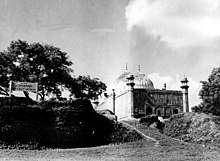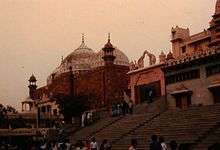Krishna Janmasthan Temple Complex
The Krishna Janmasthan Temple Complex is a group of Hindu temples in Mallapura, Mathura, Uttar Pradesh, India. These temples are built around the place where major Hindu deity Krishna was born.[1][2] The place holds religious significance since the 6th century BC.[3] The temples were destroyed multiple times throughout history, latest by Mughal emperor Aurangzeb in 1670 who erected Eidgah there. In 20th century, the new temple complex was built with the financial help from industrialists containing the Keshavdeva temple, the Garbha Griha temple at the birthplace and the Bhagavata Bhavan.
| Krishna Janmasthan Temple Complex | |
|---|---|
Keshavdeva Temple | |
| Religion | |
| Affiliation | Hinduism |
| District | Mathura district |
| Deity | Keshavdeva |
| Governing body | Shri Krishna Janmasthan Seva Sansthan |
| Year consecrated | 1958 (Keshavdeva Temple) |
| Status | Active |
| Location | |
| Location | Mathura |
| State | Uttar Pradesh |
| Country | India |
 Location in Uttar Pradesh | |
| Geographic coordinates | 27.504748°N 77.669754°E |
| Architecture | |
| Funded by | Dalmia and Birla family |
| Groundbreaking | 1953 (modern temple complex) |
| Completed | 1982 |
| Destroyed | 1670 (former temple) |
| Temple(s) | Three |
History

According to Hindu traditions, Krishna was born to Devaki and Vasudeva in a prison cell where they were confined by his maternal uncle Kansa, a king of Mathura, due to prophecy of his death by the child of Devaki.[4][5] According to tradition, a temple dedicated to Krishna was built the birthplace by his great grandson Vajranabh.[4][2] The present site known as Krishna Janmasthan (lit. 'birthplace of Krishna') was known as Katra (lit. 'market place') Keshavdeva.[3] The archaeological excavations of the site had revealed pottery and terracotta from 6th century BC.[3] It also produced some Jain sculptures as well as a large Buddhist complex including Yasha Vihara, a monastery, belonging to Gupta period (c. 400).[3] Cunningham opined that Hindus may have occupied the former Buddhist site.[4] The Vaishnava temple may have erected on the place as early as the first century.[3] Some late 8th century inscriptions mentions donations to the site by the Rashtrakutas.[4] In 1017 or 1018, Mahmud of Ghazni attacked and plundered Mahaban. Ghazni's scribe, though not accompanying him on the expedition, Al Utbi describes in his Tarikh-i-Yamini neighbouring holy town which is identified as Mathura. He wrote, "In the centre of the city there was a huge and magnificent temple, which the people believed wasn’t built by men but by the angels... Any description of the temple, either in words or in pictures, would fall short and fail to convey its beauty." Mahmud of Ghazni wrote, "if any one wished to construct a building equal to it, he would not be able to do so without spending a hundred million dinars, and the work would occupy two hundred years, even though the most able and experienced workmen were employed." He ordered to burn all the temples and demolish them. He plundered gold and silver idols and carried away a load of hundred camels.[6][7] A stone inscription in Sanskrit found from the site mentions that in Vikrama Samvat 1207 (1150) a person named Jajja who may have been a vassal of Gahadavala king built a Vishnu temple which was 'brilliantly white and touching the clouds'.[5][3] Vaishnava saints Chaitanya Mahaprabhu and Vallabhacharya visited Mathura in early 16th century.[8][5]
Abdullah, in the reign of Mughal emperor Jehangir, mentions in Tarikh-i-Daudi the destruction of Mathura and its temples by Delhi Sultan Sikandar Lodi in 16th century. Lodi had prohibited Hindus from bathing in the river and shaving of heads on the banks as well.[6][5] In the reign of Jehangir, in 1618, Raja Veer Singh Deva Bundela of Orchha had built a temple at the cost of thirty-three lakhs.[6][9][10] A French traveller Tavernier visited Mathura in 1650 and had described the octagonal temple built in red sandstone.[11][12][10] Italian traveller Niccolao Manucci who worked in Mughal court has also described the temple.[12] Mughal prince Dara Shikoh had patronised the temple and donated a railing to the temple.[9] The railing was removed Mathura governor Abdun Nabi Khan on the order of Mughal emperor Aurangzeb and he built Jama mosque on the ruins of the Hindu temples. During the Jat rebellion in Mathura, Abdul Nabi Khan was killed in 1669.[13] Aurangzeb attacked Mathura and destroyed that Keshavdeva temple in 1670 and built Shahi Eidgah in its place.[9][3]
Since 19th century


Mathura came under British control in 1804. The East India Company auctioned the land of Katra and it was purchased by Raja Patnimal, a wealthy banker[14] of Banaras.[4][15][16] Raja Patnimal wanted to build the temple but could not do so. His descendants inherited the land of Katra. His descendant Raj Krishna Das was challenged, for the ownership of 13.37 acres of land on which the shrine and the Eidgah is situated, in two civil suits by the Muslims of Mathura but the Allahabad High Court ruled in favour of Raj Krishna Das in both suits in 1935.[15][16] Kailash Nath Katju and Madanmohan Chaturvedi had helped in lawsuits. Politician and educationist Madan Mohan Malaviya acquired the land from Raj Krishna Das on 7 February 1944 at the cost of Rs. 13000 with financial help of Industrialist Jugal Kishore Birla.[4][15][16] Following death of Malaviya, Jugal Kishore Birla formed a trust named Shri Krishna Janmabhoomi Trust, later registered as the Shri Krishna Janmasthan Seva Sansthan, on 21 February 1951 and acquired the land.[15][16] Jugal Kishore Birla entrusted the construction of the new temple with another industrialist and philanthropist Jaidayal Dalmia. The construction of the temple complex was started in October 1953 with leveling of lands and completed in February 1982. His eldest son Vishnu Hari Dalmia succeeded him and served on the Trust until his death. His grandson Anurag Dalmia is Joint Managing Trustee on the Trust.[4][15] The construction was funded by other business families including Ramnath Goenka.[4] In 1968, the Trust and the Shahi Eidgah committee reached an agreement which granted the temple land to the Trust and the management of the Eidgah to the Eidgah committee as well no legal claim of the Trust on the Eidgah.[16][17] Following the demolition of the Babri Mosque in 1992, Manohar Lal Sharma, a resident of Vrindavan, has filed a petition in the Mathura District Court challenging the 1968 agreement as well as a petition to quash the Places of Religious Worship Act of 1991 which preserves the status quo as on 15 August 1947 for all places of worship.[16][18]
Ganesh Vasudev Mavalankar was the first chairman of the Trust. He was succeeded by M. A. Ayyangar, followed by Akhandananda Saraswati and Ramdev Maharaj. Nrityagopaldas is the present chairman.[15]
Temples and monuments
- Entrance of the temple complex
- Keshavdeva idol in the Keshavdeva temple
- Potra Kund
The temple complex contains Keshavdeva temple, Garbha Griha shrine and Bhagavata Bhavan.[2]
Keshavdeva Temple
The Keshavdeva Temple was built by Ramkrishna Dalmia in memory of his mother Jadiadevi Dalmia. The construction of the temple started on 29 June 1957 and inaugurated on 6 September 1958 by Hanuman Prasad Poddar.[19] It is located south of the Shahi Eidgah.
Garbha Griha shrine
It is said that Shahi Eidgah was constructed on the sabhamandapa (assembly hall) of the original temple and the garbha griha (sanctum sactorum) was left. It is considered as the place of the prison cell where Krishna is believed to have born. A marble pavilion and an underground prison cell were built on the place with spacious veranda. There is shrine near it dedicated to eight-handed goddess Yogmaya.[20][15][2] It is located against the rear wall of the Shahi Eidgah.[4]
Bhagavata Bhavan
The construction of the temple dedicated to Shrimad Bhagavata was started on 11 February 1965 and the installation ceremony of the deities were held on 12 February 1982. It includes five shrines: the main shrine having six-feet tall couple of Radha and Krishna; the shrine of Balarama, Subhadra and Jagannatha on right; the temple of Rama, Lakshmana and Sita on left; Garuda Stambha (pillar) and Chaitanya Mahaprabhu in front of Jagannatha shrine and Hanuman in front of Ram shrine; the temple of Durga and the temple with Shivalinga. The ceiling, walls and pillars of the assembly hall are adorned with frescoes depicting life events of Krishna and his associates and devotees. The text of Bhagavad Gita engraved on copper-plates adorn the walls of the parikrama (circumambulation) of the main temple.[21][2][4] There are statues of Malaviya and Birla in the complex.[4]
Other constructions include the Ayurveda Bhavan, International Guest House, shops, library and open space for performances.[4]
Potra Kund
There is a large and deep stepped water tank, Potra Kund or Pavitra Kund, in south-east of the Janmasthan temple which is said to have been used for the first bath of child Krishna after his birth.[22][2] The steps of the tank were built by Mahadji Scindia in 1782. They were restored by his descendants in 1850.[4]
Culture
| Wikimedia Commons has media related to Krishna Janmasthan Temple Complex. |
The temple is one of the most visited temple of India. Janmashtami, Diwali and Holi are the major festival celebrated at the temple.[2]
References
- Tattvāloka. 30. Sri Abhinava Vidyatheertha Educational Trust. 2007. p. 20.
- Vemsani, Lavanya (2016). Krishna in History, Thought, and Culture: An Encyclopedia of the Hindu Lord of Many Names: An Encyclopedia of the Hindu Lord of Many Names. ABC-CLIO. pp. 140–141. ISBN 978-1-61069-211-3.
- A. W. Entwistle (1 January 1987). Braj: Centre of Krishna pilgrimage. E. Forsten. pp. 125, 319–320.
- D. Anand (1992). Krishna, the Living God of Braj. Abhinav Publications. pp. 29, 125. ISBN 978-81-7017-280-2.
- Hans Bakker (1990). The History of Sacred Places in India As Reflected in Traditional Literature: Papers on Pilgrimage in South Asia. BRILL. pp. 6–7, 9. ISBN 90-04-09318-4.
- F. S. Growse. Mathura-Brindaban-The Mystical Land Of Lord Krishna. Diamond Pocket Books (P) Ltd. pp. 50–51, 52, 55. ISBN 978-81-7182-443-4.
- Fazl Ahmad (1963). Heroes of Islam Series: Mahmood of Ghazni. Sh. Muhammad Ashraf. p. 70.
- Stephen Knapp. Krishna Deities and Their Miracles. Prabhat Prakashan. p. 5.
- Audrey Truschke (1 February 2018). Aurangzeb: The Man and the Myth. Penguin Random House India Private Limited. pp. 95–96. ISBN 978-0-14-343967-7.
- Saiyid Zaheer Husain Jafri (1 January 2009). Transformations in Indian History. Anamika Publishers & Distributors. pp. 299–303. ISBN 978-81-7975-261-6. Retrieved 7 July 2012.
- Tavernier, Jean-Baptiste; Ball, V. (Valentine) (1889). Travels in India. University of Michigan. London, New York, Macmillan and co. pp. 240–241.
- The Quarterly Review of Historical Studies. 22. Institute of Historical Studies. 1983. p. 50.
- Jl Mehta (1986). Advanced Study in the History of Medieval India. Sterling Publishers Pvt. Ltd. pp. 499–500. ISBN 978-81-207-1015-3.
- Nagendra Kr Singh; A. P. Mishra (2005). Encyclopaedia of Oriental Philosophy and Religion: Hinduism : J-R. Global Vision Publishing House. p. 397. ISBN 978-81-8220-073-9.
- "History". shrikrishnajanmasthan.net. Archived from the original on 4 September 2015. Retrieved 31 July 2018.
- Ghimire, Yubaraj (15 June 1993). "Shahi Idgah adjacent to Krishna Janmabhoomi Temple at Mathura to be VHP's next target". India Today. Retrieved 31 July 2018.
- Gopal, Sarvepalli (15 October 1993). "Note 3". Anatomy of a Confrontation: Ayodhya and the Rise of Communal Politics in India. Palgrave Macmillan. pp. 95–97. ISBN 9781856490504.
- Dhavan, Rajeev (11 July 2003). "Ayodhya solutions". The Hindu. Retrieved 31 July 2018.
- "Keshavdeva". shrikrishnajanmasthan.net. Retrieved 31 July 2018.
- "Garbha Griha". shrikrishnajanmasthan.net. Retrieved 31 July 2018.
- "Bhagvata Bhavan". shrikrishnajanmasthan.net. Retrieved 31 July 2018.
- "Krishna Janmasthan Temple". UP Tourism. Retrieved 31 July 2018.

